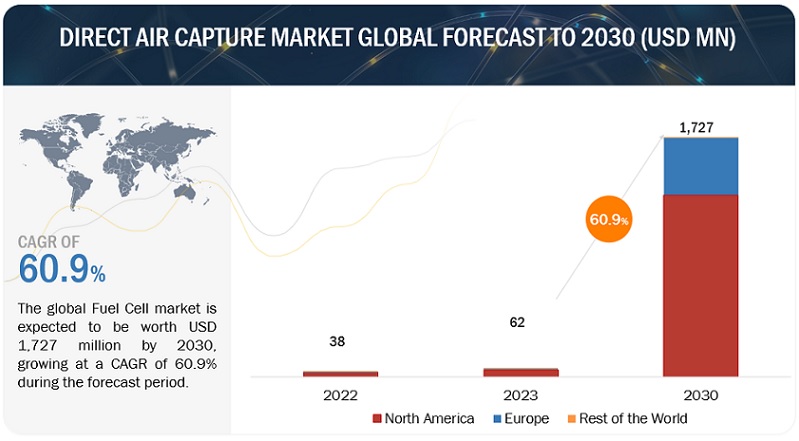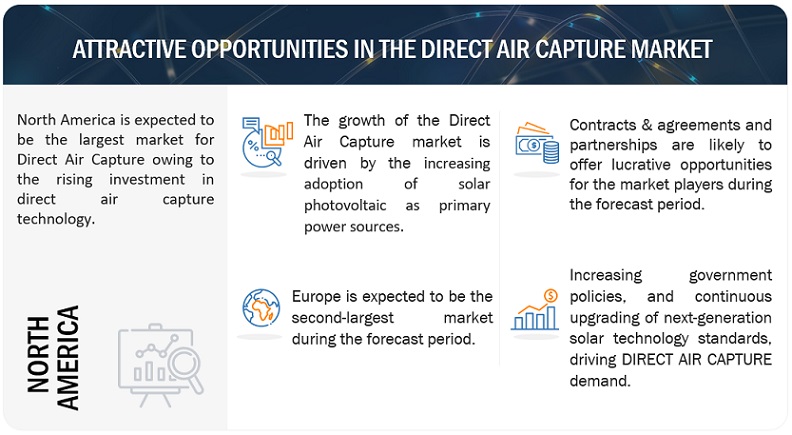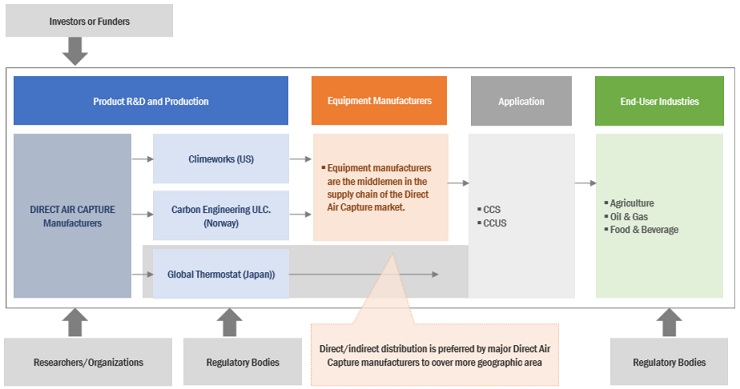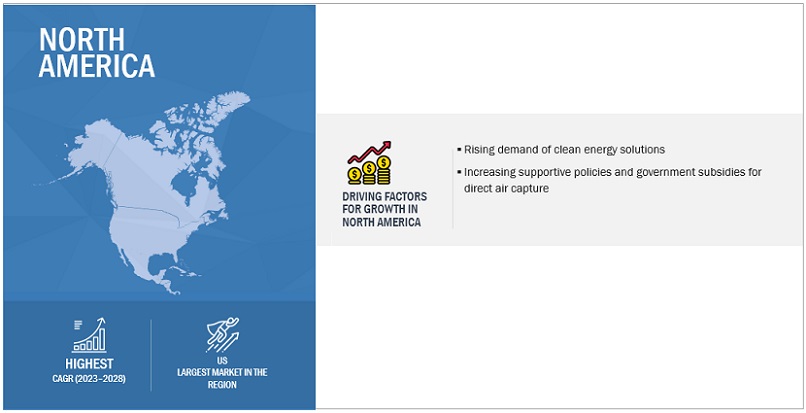※レポートは、MarketsandMarkets社が作成したもので英文表記です。
レポートの閲覧に際してはMarketsandMarkets社のDisclaimerをご確認ください。
[160 Pages Report] The global direct air capture market in terms of revenue was estimated to be worth $62 million in 2023 and is poised to reach $1,727 million by 2030, growing at a CAGR of 60.9% from 2023 to 2030. Stringent government regulations and increasing emphasis on synthetic fuels to reduce carbon emissions are few of the factors accelerating the growth of direct air capture market.


Direct Air Capture Market Dynamics
Driver: Increasing emphasis on global net zero emission goals
The escalating global environmental concerns, particularly the acknowledgment that CO2 emissions contribute to nearly 76% of global greenhouse gas emissions, play a crucial role in driving the adoption of Direct Air Capture (DAC) systems. According to the Global Monitoring Lab of the National Oceanic and Atmospheric Administration (NOAA), the global average atmospheric carbon dioxide reached 417.06 parts per million ("ppm") in 2022, reflecting a notable increase of 2.13 ppm from the previous year. Governments worldwide are taking proactive measures to achieve net-zero emission targets. Over 140 countries, including major contributors to pollution such as China, the United States, India, and the European Union, have committed to attaining net-zero emissions by 2050. The intensified focus on achieving net-zero emissions, which necessitates not only emission reduction but also active removal of existing CO2, creates a conducive environment for the potential adoption and success of Direct Air Capture (DAC) technologies.
Restraint: Infrastructural Hurdles to Scaling Up Direct Air Capture
Transportation and Storage infrastructure is the backbone of the carbon management industry. Pipeline is technologically feasible for large scale applications and is already commercially deployed on a limited scale. According to the International Energy Agency (IEA), the pipeline projects dedicated to CO2 storage capacity has the potential to surpass 420 million metric tons (Mt) annually by 2030. Nevertheless, despite these strides, it remains insufficient to meet the projected storage needs of approximately 1,200 million metric tons (Mt) of CO2 per year by 2030, as delineated in the Net Zero Emissions (NZE) Scenario.
Opportunities: Expansion of the utilization of Direct Air Capture (DAC) on a larger scale.
Globally, twenty-seven Direct Air Capture (DAC) plants have been commissioned, collectively capturing nearly 0.01 million metric tons of CO2 annually. Presently, there are plans for at least 130 DAC facilities at various stages of development. Projections indicate that DAC technologies are poised to capture over 85 million tons of CO2 by 2030 and a substantial 980 million tons of CO2 by 2050. Governments worldwide are actively supporting DAC technologies as part of their strategies to achieve net-zero emission goals, creating an opportunity for the technology to be scaled up on a larger magnitude. In line with this trend, Carbon Engineering ULC is set to establish a plant in 2025 with the capacity to capture up to 1 million metric tons of CO2 annually.
Challenges: High cost of direct air capture technology
Direct Air Capture (DAC) employs renewable energy sources to extract existing CO2 from the atmosphere, but it remains comparatively expensive when contrasted with alternative carbon dioxide removal methods. The process of DAC involves energy-intensive separation, and as a relatively nascent technology, there are limited projects and companies operating in this field, contributing to the higher costs associated with direct air capture. According to the World Resource Institute (WRI), the cost range for capturing CO2 directly from the atmosphere spans between USD 250 and USD 600. This cost variability is influenced by factors such as the chosen technology, the utilization of low-carbon energy sources, and the scale of deployment. While DAC faces current cost challenges, ongoing technological advancements could catalyze widespread adoption and potentially lead to a significant reduction in costs.
Direct Air Capture Market Ecosystem
In this market, few companies stand out as established and financially stable providers of direct air capture technology. With years of experience, these companies boast a diverse product portfolio, cutting-edge technologies, and robust global sales and marketing networks. Their proven track record in the industry positions them as reliable and trusted partners for customers seeking direct air capture solutions. These companies have demonstrated their ability to adapt to market dynamics and consistently deliver high-quality products and services, making them leaders in meeting the demands of the oil and gas sector. Companies in this market include Climeworks (Switzerland), Carbon Engineering ULC. (Canada), Global Thermostat (US), Heirloom Carbon Technologies (US), Skytree (Netherlands).

The Liquid-DAC (L-DAC), by technology, is expected to be the largest market during the forecast period.
This report segments the direct air capture market based on technology into different types: Solid-DAC (S-DAC), Liquid-DAC (L-DAC), Electrochemical-DAC (E-DAC) and others. The Liquid-DAC (L-DAC) segment is expected to be hold the largest share during the forecast period. Liquid-Direct Air Capture (L-DAC) achieves a notable capture capacity by utilizing solvents with a high CO2 absorption capacity. Additionally, Liquid-DAC (L-DAC) exhibits lower energy intensity when compared to alternative technologies like Solid-Direct Air Capture (Solid-DAC).
By application, carbon, capture and storage (CCS) is expected to be the largest growing during the forecast period.
This report segments the direct air capture market based on phase into two segments: Carbon capture, and storage (CCS) and carbon capture, utilization, and storage (CCUS). The carbon capture, and storage is expected to be the fastest and largest growing during the forecast period. The growth is attributed by the adoption of Carbon mineralization, which involves the permanent removal of carbon dioxide by converting it into a solid mineral form, usually a carbonate, through a chemical reaction with specific rocks.
“North America: The largest region in the direct air capture market.”
North America is expected to be the largest region in the market between 2023–2030, followed by Europe. North America's leading position is notably supported by robust policies and market initiatives. The backing of the US Department of Energy, particularly through programs like the The Regional Direct Air Capture (DAC) Hubs program. Under this program, US will develop four regional direct air capture hubs. Furthermore, policy frameworks have been put in place to encourage the deployment of DAC such as 45 Q tax credit and California low Carbon Fuel Standard.The regional direct air capture market is experiencing growth due to the presence of leading solution providers like Global Thermostat (US), Carbon Engineering ULC. (Canada) and Heirloom Carbon Technologies (US).

Key Market Players
The market is dominated by a few major players that have a wide regional presence. The major players in the direct air capture market include Climeworks (Switzerland), Carbon Engineering ULC. (Canada), Global Thermostat (US), Heirloom Carbon Technologies (US), Skytree (Netherlands). Between 2019 and 2023, Strategies such as new product launches, contracts, agreements, and expansions are followed by these companies to capture a larger share of the market.
Get online access to the report on the World's First Market Intelligence Cloud
- Easy to Download Historical Data & Forecast Numbers
- Company Analysis Dashboard for high growth potential opportunities
- Research Analyst Access for customization & queries
- Competitor Analysis with Interactive dashboard
- Latest News, Updates & Trend analysis
Get online access to the report on the World's First Market Intelligence Cloud
- Easy to Download Historical Data & Forecast Numbers
- Company Analysis Dashboard for high growth potential opportunities
- Research Analyst Access for customization & queries
- Competitor Analysis with Interactive dashboard
- Latest News, Updates & Trend analysis
Scope of the Report
|
Report Metric |
Details |
|
Market size available for years |
2021–2030 |
|
Base year considered |
2022 |
|
Forecast period |
2023–2030 |
|
Forecast units |
Value (USD Million/Billion) |
|
Segments Covered |
Direct Air Capture Market by Technology, Application, source, and Region. |
|
Geographies covered |
North America, Europe, Middle East & Africa, and Rest of the world. |
|
Companies covered |
Climeworks(Switzerland), Carbon Engineering ULC.(Canada), Global thermostat (US), Heirloom Carbon Technologies(US), and Soletair Power (Finland), CarbonCapture Inc.(US), Avnos, Inc. (US), Noya PBC (US), Skytree (Netherlands), RepAir (Israel), MISSION ZERO TECHNOLOGIES (England, Carbyon (Netherlands), Octavia carbon (Kenya), Capture6 (US), Sustaera Inc. (US), Spiritus (US), Infinitree LLC (US), Mosaic Materials Inc. (US), Carbon Collect Limited (Ireland), Immaterial ( England), and Southern Green Gas Limited (Australia) |
This research report categorizes the market based on technology, application, source, and region.
On the basis of technology, the direct air capture market has been segmented as follows:
- Solid-DAC (S-DAC)
- Liquid-DAC (L-DAC)
- Electrochemical-DAC (E-DAC)
On the basis of application, the market has been segmented as follows:
- Carbon Capture, and Storage (CCS)
- Carbon Capture, Utilization and Storage (CCUS)
On the basis of source, the market has been segmented as follows:
- Electricity
- Heat
On the basis of region, the market has been segmented as follows:
- North America
- Europe
- Rest of the world
Recent Developments
- In September 2023, Climeworks collaborated with Great Carbon valley, a pioneering Kenyan systems integrator and project development venture to explore the development of large-scale projects.
- In November 2023, Heirloom Carbon Technologies signed an agreement with CarbonCure, a manufacturer of carbon removal or carbon utilization technologies to capture CO2 from the atmosphere and permanently embed it in concrete. Under this agreement CarbonCure permanently store CO2 captured by Heirloom’s DAC facilities in nearby concrete plants.
- In October 2022, Carbon Capture, Inc. and Fluor Corporation entered into a contract. Under this contract, Fluor Corporation, a leading global engineering, procurement, and construction (EPC) firm provides engineering and project integration services for Project Bison
- In July 2021, Carbon Engineering ULC. and Lanza Tech, carbon recycling technology provider entered into partnership to generate sustainable aviation fuel (SAF) from atmospheric carbon dioxide (CO2), which is known as Project AtmosFUEL. The project will produce more than 100 million litres of SAF each year, once operational by the year 2031.
Frequently Asked Questions (FAQ):
What is the current size of the direct air capture market?
The current market size of the direct air capture market is USD 38 million in 2022.
What are the major drivers for the direct air capture market?
Growing expansion of solar PV and transition towards sustainable energy consumption practices has emerged as some of major drivers for the direct air capture market.
Which is the largest region during the forecasted period in the direct air capture market?
North America is expected to dominate the direct air capture market between 2023–2030, followed by Europe.
Which is the largest segment, by technology, during the forecasted period in the direct air capture market?
Liquid-DAC segment is expected to be the largest market during the forecast period due to lower energy intensity as compared to other technologies such as S-DAC
Which is the fastest growing segment, by application, during the forecasted period in the direct air capture market?
Carbon capture, and storage is expected to be the fastest growing market during the forecast period. .


